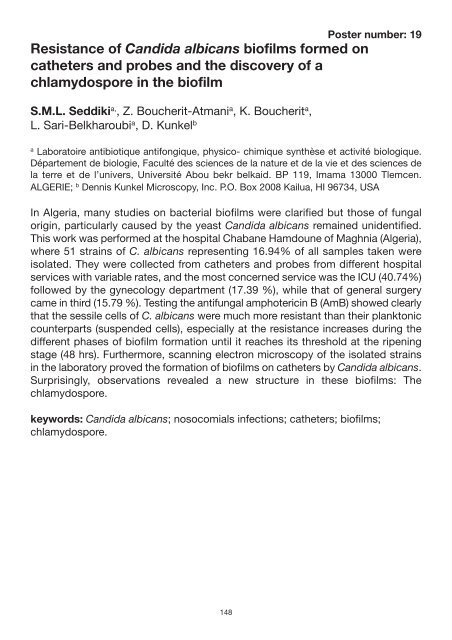Candida Infection Biology – fungal armoury, battlefields ... - FINSysB
Candida Infection Biology – fungal armoury, battlefields ... - FINSysB
Candida Infection Biology – fungal armoury, battlefields ... - FINSysB
Create successful ePaper yourself
Turn your PDF publications into a flip-book with our unique Google optimized e-Paper software.
Poster number: 19<br />
Resistance of <strong>Candida</strong> albicans biofilms formed on<br />
catheters and probes and the discovery of a<br />
chlamydospore in the biofilm<br />
S.M.L. Seddiki a, , Z. Boucherit-Atmani a , K. Boucherit a ,<br />
L. Sari-Belkharoubi a , D. Kunkel b<br />
a Laboratoire antibiotique antifongique, physico- chimique synthèse et activité biologique.<br />
Département de biologie, Faculté des sciences de la nature et de la vie et des sciences de<br />
la terre et de l’univers, Université Abou bekr belkaid. BP 119, Imama 13000 Tlemcen.<br />
ALGERIE; b Dennis Kunkel Microscopy, Inc. P.O. Box 2008 Kailua, HI 96734, USA<br />
In Algeria, many studies on bacterial biofilms were clarified but those of <strong>fungal</strong><br />
origin, particularly caused by the yeast <strong>Candida</strong> albicans remained unidentified.<br />
This work was performed at the hospital Chabane Hamdoune of Maghnia (Algeria),<br />
where 51 strains of C. albicans representing 16.94% of all samples taken were<br />
isolated. They were collected from catheters and probes from different hospital<br />
services with variable rates, and the most concerned service was the ICU (40.74%)<br />
followed by the gynecology department (17.39 %), while that of general surgery<br />
came in third (15.79 %). Testing the anti<strong>fungal</strong> amphotericin B (AmB) showed clearly<br />
that the sessile cells of C. albicans were much more resistant than their planktonic<br />
counterparts (suspended cells), especially at the resistance increases during the<br />
different phases of biofilm formation until it reaches its threshold at the ripening<br />
stage (48 hrs). Furthermore, scanning electron microscopy of the isolated strains<br />
in the laboratory proved the formation of biofilms on catheters by <strong>Candida</strong> albicans.<br />
Surprisingly, observations revealed a new structure in these biofilms: The<br />
chlamydospore.<br />
keywords: <strong>Candida</strong> albicans; nosocomials infections; catheters; biofilms;<br />
chlamydospore.<br />
148


